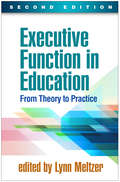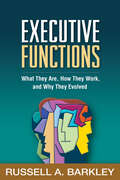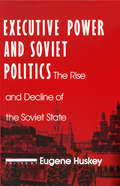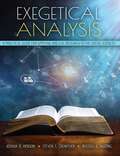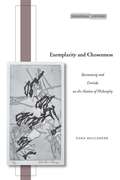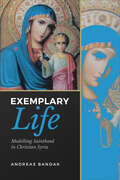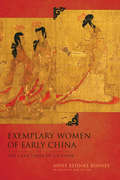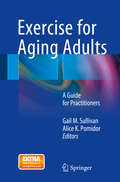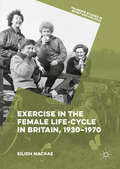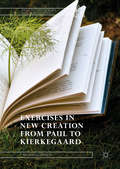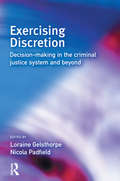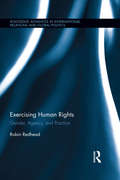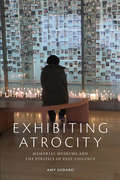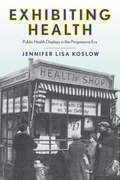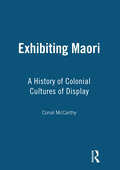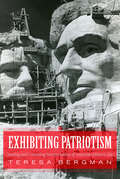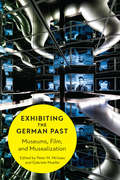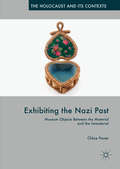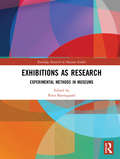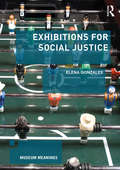- Table View
- List View
Executive Function Skills in the Classroom: Overcoming Barriers, Building Strategies (The Guilford Practical Intervention in the Schools Series)
by Peg Dawson Laurie Faith Carol-Anne BushWith insight and humor, this motivating guide shows how to bring executive functions (EF) to the forefront in K–8 classrooms--without adopting a new curriculum or scripted program. Ideal for professional development, the book includes flexible, practical, research-based ideas for implementation in a variety of classroom contexts. It shares stories from dozens of expert teachers who are integrating explicit EF support across the school day. Provided is a clear approach for talking about EF barriers and strategies as part of instruction, and working as a class to problem-solve, explore, and apply the strategies that feel right for each student. Purchasers get access to a Web page where they can download and print several reproducible tools in a convenient 8 1/2" x 11" size. This book is in The Guilford Practical Intervention in the Schools Series, edited by Sandra M. Chafouleas.
Executive Function in Education, Second Edition: From Theory to Practice
by Lynn MeltzerThis groundbreaking volume, now revised and updated, has given thousands of educators and clinicians a deeper understanding of executive function (EF) processes in typically developing children and those with learning difficulties and developmental disabilities. The book elucidates how PreK–12 students develop such key capacities as goal setting, organization, cognitive flexibility, working memory, and self-monitoring. Leading experts in education, neuroscience, and psychology explore the links between EF and academic performance and present practical applications for assessment and instruction. Exemplary practices for supporting students with EF difficulties in particular content areas--reading, writing, and math--are reviewed. New to This Edition *Expanded coverage of reading--chapters on recent fMRI research findings; working memory and reading; and self-regulation and reading comprehension. *Chapter on early childhood. *Chapter on embedding EF strategies in the curriculum *Updated throughout with a decade's worth of significant advances in research, theory, and educational best practices. See also Meltzer's authored book Promoting Executive Function in the Classroom, which provides easy-to-implement assessment tools, teaching techniques and activities, and planning aids.
Executive Functions: What They Are, How They Work, and Why They Evolved
by Russell A. BarkleyThis groundbreaking book offers a comprehensive theory of executive functioning (EF) with important clinical implications. Synthesizing cutting-edge neuropsychological and evolutionary research, Russell A. Barkley presents a model of EF that is rooted in meaningful activities of daily life. He describes how abilities such as emotion regulation, self-motivation, planning, and working memory enable people to pursue both personal and collective goals that are critical to survival. Key stages of EF development are identified and the far-reaching individual and social costs of EF deficits detailed. Barkley explains specific ways that his model may support much-needed advances in assessment and treatment.
Executive Power and Soviet Politics (Contemporary Soviet - Post-soviet Politics Ser.)
by Eugene HuskeyEver since the behavioral revolution reached Communist studies more than 2 decades ago, Western scholarship has tended to ignore the powerful and unwieldy institutional structure of the Soviet government. Today, suddenly, it is clear that the dramatic political and legislative reforms of the Gorbachev years will remain incomplete as long as the issues of state bureaucratic power and executive prerogative are unresolved. This volume, brings together original studies of the Soviet executive under Gorbachev by specialists including Barbara Chotiner, Stephen Fortescue, Brnda Horrigan, Ellen Jones, Wayne Limberg, T.H. Rigby and Louise Shelley. Among the topics covered are the major economic, national security and law enforcement ministries, the presidency, the cabinet and questions of presidential-ministerial, presidential-presidential, legislative-executive and party-state relations.
Exegetical Analysis: A Practical Guide for Applying Biblical Research to the Social Sciences
by Russell L. Huizing Joshua D. Henson Steven S. CrowtherExegetical Analysis: A Practical Guide for Applying Biblical Research to the Social Sciences delivers a fresh perspective on biblical research. Designed specifically for those who wish to explore biblical principles in the social-scientific context, Exegetical Analysis provides practical and methodological insights that will guide the reader in writing an exegetical research paper from start to finish. <P><P>Each chapter takes the reader step-by-step through the exegetical research process. Diverging from typical hermeneutical texts, Exegetical Analysis provides visually and mentally stimulating content such as illustrations, charts, figures and concept maps designed not only to teach methodology but also how to apply it. With thought-provoking reflective exercises and content authored by three emerging leaders in the field of biblical research in the social sciences, this book is practical enough for the novice biblical research student and extensive enough for the seasoned scholar.
Exemplarity and Chosenness
by Dana HollanderCrosnoe (sociology, U. of Texas, Austin) presents findings from the first-ever national study of the school readiness of Mexican immigrant children. As the number of Mexican immigrants to the U. S. continues to increase, the author argues, it is critical that we determine ways to improve the educational prospects of the Mexican immigrant children if they are to eventually become prosperous, productive, fulfilled citizens. The study examines various aspects of their lives--including health, the home environment, and childcare arrangements--to identify what helps and what hurts these children in the first years of elementary school, and concludes with some recommended social policy changes For educators, policymakers, and parents. Annotation ©2007 Book News, Inc. , Portland, OR (booknews. com)
Exemplary Life: Modelling Sainthood in Christian Syria (Anthropological Horizons)
by Andreas BandakBased on over five years of ethnographic fieldwork in Syria, Exemplary Life focuses on the life of a Damascus woman, Myrna Nazzour, who serves as an aspirational figure in her community. Myrna is regarded by her followers as an exemplary figure, a living saint, and the messages, apparitions, stigmata, and oil that have marked Myrna since 1982 have corroborated her status as chosen by God. Exemplary Life probes the power of examples, the modelling of sainthood around Myrna’s figure, and the broader context for Syrian Christians in the changing landscape of the Middle East. The book highlights the social use of examples such as the ones inhabited by Myrna’s devout followers and how they reveal the broader structures of illustration, evidence, and persuasion in social and cultural settings. Andreas Bandak argues that the role of the example should incite us to investigate which trains of thought set local worlds in motion. In doing so, Exemplary Life presents a novel frame for examining how religion comes to matter to people and adds a critical dimension to current anthropological engagements with ethics and morality.
Exemplary Women of Early China
by Anne Behnke KinneyWhen should a woman disobey her father, contradict her husband, or shape the policy of a ruler? According to the Lienü zhuan, or Categorized Biographies of Women, it is not only appropriate but necessary for women to offer counsel when fathers, husbands, sons, and rulers stray from virtue. The earliest Chinese text devoted to the moral education of women, the Lienü zhuan was compiled by Liu Xiang (79--8 B.C.E.) at the end of the Han dynasty (202 B.C.E.--9 C.E.) and recounts the deeds of both virtuous and wicked women. Informed by early legends, fictionalized historical accounts, and formal speeches on statecraft, the text taught generations of Chinese women to cultivate filial piety and maternal kindness and undertake such practices as suicide and self-mutilation to preserve chastity and reform wayward men. The Lienü zhuan's stories inspired artists for a millennium and found their way into local and dynastic histories. An innovative work for its time, the text remains a critical tool for mapping women's social, political, and domestic roles at a formative time in China's development.
Exemplary Women of Early China: The Lienü zhuan of Liu Xiang (Translations from the Asian Classics)
by Anne Behnke KinneyIn early China, was it correct for a woman to disobey her father, contradict her husband, or shape the public policy of a son who ruled over a dynasty or state? According to the Lienü zhuan, or Categorized Biographies of Women, it was not only appropriate but necessary for women to step in with wise counsel when fathers, husbands, or rulers strayed from the path of virtue. Compiled toward the end of the Former Han dynasty (202 BCE-9 CE) by Liu Xiang (79-8 BCE), the Lienü zhuan is the earliest extant book in the Chinese tradition solely devoted to the education of women. Far from providing a unified vision of women's roles, the text promotes a diverse and sometimes contradictory range of practices. At one extreme are exemplars resorting to suicide and self-mutilation as a means to preserve chastity and ritual orthodoxy. At the other are bold and outspoken women whose rhetorical mastery helps correct erring rulers, sons, and husbands. The text provides a fascinating overview of the representation of women's roles in early legends, formal speeches on statecraft, and highly fictionalized historical accounts during this foundational period of Chinese history.Over time, the biographies of women became a regular feature of dynastic and local histories and a vehicle for expressing and transmitting concerns about women's social, political, and domestic roles. The Lienü zhuan is also rich in information about the daily life, rituals, and domestic concerns of early China. Inspired by its accounts, artists across the millennia have depicted its stories on screens, paintings, lacquer ware, murals, and stone relief sculpture, extending its reach to literate and illiterate audiences alike.
Exercise Programming for Older Adults
by Janie ClarkThe exercise programming guidelines provided in this book focus on functional fitness training and safety and demonstrate how physical activities supervised by activities personnel can strongly benefit participants’quality of life. Exercise Programming for Older Adults guarantees that exercise programming attains a balance between the three major physical components--aerobic, strength, and flexibility training--and that each component is properly administered. The techniques and applications described are geared toward those with prevalent conditions of aging such as arthritis, osteoporosis, joint replacement, cardiovascular disease, stroke, and chronic obstructive pulmonary disease.This essential handbook arms the reader with a multidisciplinary approach to exercise management for elderly populations. The chapter authors are experts from the fields of fitness instruction, nursing, physical therapy, medicine, research, and exercise physiology. As they address the theory and practice of providing sound exercise programming, specific exercises are described and illustrated, with emphasis on functional fitness outcomes, safety precautions, fall prevention, and practical adaptations for low-fit and physically limited participants. Chapter discussions include:aerobic exercisestrength trainingflexibility trainingthe administration of mild posture and breathing exercises for debilitated individuals with poor prognosespositioning and transfer techniques essential for optimal activities management of neurologically impaired patientswarm water exercise programs designed for persons with low tolerance of conventional training methodsExercise Programming for Older Adults serves as a vital resource for activity coordinators in long-term care settings and for group fitness instructors and personal trainers who serve older adult and frail elderly clientele. Readers will discover alternative techniques and applications for maximizing the physical and mental therapeutic benefits of exercise and developing the functional fitness of even the most physically challenged participants.
Exercise for Aging Adults
by Gail M. Sullivan Alice K. PomidorThis book translates the new findings in exercise research for the elderly for busy practitioners, trainees, students and administrators. This book provides practical strategies that can be implemented immediately in the common settings in which practitioners care for adults. The format includes key points and case examples which showcase the strong evidence supporting exercise by older adults as a key tool to enhance health, prevent serious outcomes, such as hospitalization and functional loss, and as part of the treatment plan for diseases that are common in older adults. Written by experts in the field of exercise in older persons, this book is a guide to maintaining quality of life and functional independence from frail to healthy aging adults. Strategies and exercises are discussed for specific care settings and illustrated via links to video examples, to ensure readers can immediately apply described techniques. Exercise for Aging Adults: A Guide for Practitioners is a useful tool for physicians, residents in training, medical students, physical therapists, gerontology advance practice nurse practitioners, assisted living facility administrators, directors of recreation, and long-term care directors.
Exercise in the Female Life-Cycle in Britain, 1930-1970
by Eilidh MacraeThis book examines how adolescence, menstruation and pregnancy were experienced or 'managed' by active women in Britain between 1930 and 1970, and how their athletic life-styles interacted with their working lives, marriage and motherhood. It explores the gendered barriers which have influenced women's sporting experiences. Women's lives have always been shaped by the socially and physically constructed life-cycle, and this is all the more apparent when we look at female exercise. Even self-proclaimed 'sporty' women have had to negotiate obstacles at various stages of their lives to try and maintain their athletic identity. So how did women overcome these obstacles to gain access to exercise in a time when the sportswoman was not an image society was wholly comfortable with? Oral history testimony and extensive archival research show how the physically and socially constructed female life-cycle shaped women's experiences of exercise and sport throughout these decades.
Exercises in New Creation from Paul to Kierkegaard (Radical Theologies and Philosophies)
by T. Wilson DickinsonThis book unfolds a vision for philosophical theology centered on the practices of the care of the self, the city, and creation. Rooted in Paul’s articulation of the wisdom of the cross, and in conversation with ecological, radical, and political theologies; continental philosophy; and political ecology, it addresses the challenge of injustice and ecological catastrophe. Part one reads 1 Corinthians as an exercise in reading and writing that shapes and changes relationships and capabilities. Part two follows this alternative path for theology through Derrida and Kierkegaard, and neglected trajectories in Origen, Augustine, and Luther. Along the way, reading and writing are explored as exercises that transform selves, communities, and even habitats. They are creaturely acts that can scandalize the dominant orders of consumption and competition for the ends of love and justice. This is a philosophical theology engaged with political ecology, exercises that help cultivate new creation.
Exercising Discretion
by Loraine Gelsthorpe Nicola PadfieldThe exercise of discretion in the criminal justice system and related agencies often plays a key part in decisions which are made, but definitions of discretion are not clear, and despite widespread recognition of its importance there is much controversy on its nature and legitimacy. This book seeks to explore the importance of discretion to an understanding of the nature of the 'making of justice' in theory and practice, taking as its starting point the wide discretionary powers wielded by many of the key players in the criminal justice and related systems. It focuses on the core elements and contexts of discretion, looking at the power, ability, authority and duties of individuals, officials and organisations to decide, select or interpret vague standards, requirements or statutory uncertainties.
Exercising Human Rights: Gender, Agency and Practice (Routledge Advances in International Relations and Global Politics)
by Robin RedheadExercising Human Rights investigates why human rights are not universally empowering and why this damages people attempting to exercise rights. It takes a new approach in looking at humans as the subject of human rights rather than the object and exposes the gendered and ethnocentric aspects of violence and human subjectivity in the context of human rights. Using an innovative visual methodology, Redhead shines a new critical light on human rights campaigns in practice. She examines two cases in-depth. First, she shows how Amnesty International depicts women negatively in their 2004 ‘Stop Violence against Women Campaign’, revealing the political implications of how images deny women their agency because violence is gendered. She also analyses the Oka conflict between indigenous people and the Canadian state. She explains how the Canadian state defined the Mohawk people in such a way as to deny their human subjectivity. By looking at how the Mohawk used visual media to communicate their plight beyond state boundaries, she delves into the disjuncture between state sovereignty and human rights. This book is useful for anyone with an interest in human rights campaigns and in the study of political images.
Exhibiting Atrocity: Memorial Museums and the Politics of Past Violence
by Amy SodaroToday, nearly any group or nation with violence in its past has constructed or is planning a memorial museum as a mechanism for confronting past trauma, often together with truth commissions, trials, and/or other symbolic or material reparations. Exhibiting Atrocity documents the emergence of the memorial museum as a new cultural form of commemoration, and analyzes its use in efforts to come to terms with past political violence and to promote democracy and human rights. Through a global comparative approach, Amy Sodaro uses in-depth case studies of five exemplary memorial museums that commemorate a range of violent pasts and allow for a chronological and global examination of the trend: the U.S. Holocaust Memorial Museum in Washington, DC; the House of Terror in Budapest, Hungary; the Kigali Genocide Memorial Centre in Rwanda; the Museum of Memory and Human Rights in Santiago, Chile; and the National September 11 Memorial Museum in New York. Together, these case studies illustrate the historical emergence and global spread of the memorial museum and show how this new cultural form of commemoration is intended to be used in contemporary societies around the world.
Exhibiting Creative Geographies: Bringing Research Findings to Life
by Candice P. BoydThis open access book provides a detailed example of arts-based knowledge translation from start to finish for any scholar interested in communicating research findings through art. Firmly grounded in the GeoHumanities, a field at the intersection of cultural geography and the arts, this book explores the theory and practice of research exhibitions. Commencing with an overview of arts in health and art-science collaborations, this book also explores the concept of ‘affective knowledge translation’. In doing so, it describes the creative co-production, staging, and evaluation of the Finding Home exhibition which toured Australia during 2021. As a demonstration of the power of art to engage audiences, raise awareness of social issues, communicate lived experience, and extend the reach of cultural geographic research, this book is relevant to academics from any discipline who are keen to increase the societal impact of their work.
Exhibiting Health: Public Health Displays in the Progressive Era (Critical Issues in Health and Medicine)
by Jennifer Lisa KoslowIn the early twentieth century, public health reformers approached the task of ameliorating unsanitary conditions and preventing epidemic diseases with optimism. Using exhibits, they believed they could make systemic issues visual to masses of people. Embedded within these visual displays were messages about individual action. In some cases, this meant changing hygienic practices. In other situations, this meant taking up action to inform public policy. Reformers and officials hoped that exhibits would energize America's populace to invest in protecting the public's health. Exhibiting Health is an analysis of the logic of the production and the consumption of this technique for popular public health education between 1900 and 1930. It examines the power and limits of using visual displays to support public health initiatives.
Exhibiting Madness in Museums: Remembering Psychiatry Through Collection and Display (Routledge Research in Museum Studies)
by Catharine Coleborne Dolly MacKinnonWhile much has been written on the history of psychiatry, remarkably little has been written about psychiatric collections or curating. Exhibiting Madness in Museums offers a comparative history of independent and institutional collections of psychiatric objects in Australia, New Zealand, Canada and the United Kingdom. Leading scholars in the field investigate collectors, collections, their display, and the reactions to exhibitions of the history of insanity. Linked to the study of medical museums this work broadens the study of the history of psychiatry by investigating the significance and importance of the role of twentieth-century psychiatric communities in the preservation, interpretation and representation of the history of mental health through the practice of collecting. In remembering the asylum and its different communities in the twentieth century, individuals who lived and worked inside an institution have struggled to preserve the physical character of their world. This collection of essays considers the way that collections of objects from the former psychiatric institution have played a role in constructions of its history. It historicises the very act of collecting, and also examines ethical problems and practices which arise from these activities for curators and exhibitions.
Exhibiting Maori: A History of Colonial Cultures of Display
by Conal McCarthyThis richly illustrated book presents a comprehensive assessment of the display of Maori culture from the nineteenth century to today. In doing so, Exhibiting Maori traces the long journey from curio to specimen, artefact, art and taonga (treasure). Drawing on extensive and groundbreaking research, Exhibiting Maori reveals for the first time the remarkable story of Maori resistance to, involvement in, and eventual capture of the display of their culture.Ranging across museums, world fairs, fine art and tourism, Exhibiting Maori fuses museum studies, anthropology, and visual and material culture to uncover a history of active Maori engagement with the colonial culture of display.
Exhibiting Patriotism: Creating and Contesting Interpretations of American Historic Sites
by Teresa BergmanAmerican nationalism, patriotism and citizenship are proudly on display at historical sites across America—but they are also contested and reshaped by visitors and their engagement with those places. In Exhibiting Patriotism, Bergman analyzes exhibits, interpretive materials, and orientation films at major US sites, from Mt. Rushmore and to the USS Arizona Memorial, where controversy has erupted over the stories they tell about the past. She shows how historic narratives are the result of dynamic relationships between institutions and the public, and how these relationships are changing in an era when museums are becoming more visitor-centered, seeing visitors as partners in historical interpretation. Drawing on film theory, memory studies, visual communication, and visitor studies, Bergman offers an important analysis for scholars and professionals in American studies, museum studies, public history, and communication and media studies.
Exhibiting the German Past
by Peter M. Mcisaac Gabriele MuellerWhile scholars recognize both museums and films as sites where historical knowledge and cultural memory are created, the convergence between their methods of constructing the past has only recently been acknowledged. The essays in Exhibiting the German Past examine a range of films, museums, and experiences which blend the two, considering how authentic objects and cinematic techniques are increasingly used in similar ways by both visual media and museums.This is the first collection to focus on the museum-film connection in German-language culture and the first to approach the issue using the concept of "musealization," a process that, because it engages the cultural destruction wrought by modernization, offers new means of constructing historical knowledge and shaping collective memory within and beyond the museum's walls. Featuring a wide range of valuable case studies, Exhibiting the German Past offers a unique perspective on the developing relationship between museums and visual media.
Exhibiting the Nazi Past: Museum Objects Between the Material and the Immaterial (The Holocaust and its Contexts)
by Chloe PaverThis book is the first full-length study of the museum object as a memory medium in history exhibitions about the Nazi era, the Second World War, and the Holocaust. Over recent decades, German and Austrian exhibition-makers have engaged in significant programmes of object collection, often in collaboration with witnesses and descendants. At the same time, exhibition-makers have come to recognise the degree to which the National Socialist era was experienced materially, through the loss, acquisition, imposition, destruction, and re-purposing of objects. In the decades after 1945, encounters with material culture from the Nazi past continued, both within the family and in the public sphere. In analysing how these material engagements are explored in the museum, the book not only illuminates a key aspect of German and Austrian cultural memory but contributes to wider debates about relationships between the human and object worlds.
Exhibitions as Research: Experimental Methods in Museums (Routledge Research in Museum Studies)
by Peter BjerregaardExhibitions as Research contends that museums would be more attractive to both researchers and audiences if we consider exhibitions as knowledge-in-the-making rather than platforms for disseminating already-established insights. Analysing the theoretical underpinnings and practical challenges of such an approach, the book questions whether it is possible to exhibit knowledge that is still in the making, whilst also considering which concepts of "knowledge" apply to such a format. The book also considers what the role of audience might be if research is extended into the exhibition itself. Providing concrete case studies of projects where museum professionals have approached exhibition making as a knowledge-generating process, the book considers tools of application and the challenges that might emerge from pursuing such an approach. Theoretically, the volume analyses the emergence of exhibitions as research as part of recent developments within materiality theories, object-oriented ontology and participatory approaches to exhibition-making. Exhibitions as Research will be of interest to academics and students engaged in the study of museology, material culture, anthropology and archaeology. It will also appeal to museum professionals with an interest in current trends in exhibition-making.
Exhibitions for Social Justice (Museum Meanings)
by Elena GonzalesExhibitions for Social Justice assesses the state of curatorial work for social justice in the Americas and Europe today. Analyzing best practices and new curatorial work to support all those working on exhibitions, Gonzales expounds curatorial practices that lie at the nexus of contemporary museology and neurology. From sharing authority, to inspiring action and building solidarity, the book demonstrates how curators can make the most of visitors’ physical and mental experience of exhibitions. Drawing on ethnographic and archival work at over twenty institutions with nearly eighty museum professionals, as well as scholarship in the public humanities, visual culture, cultural studies, memory studies, and brain science, this project steps back from the detailed institutional histories of how exhibitions come to be. Instead, it builds a set of curatorial practices by examining the work behind the finished product in the gallery. Demonstrating that museums have the power to help our society become more hospitable, equitable, and sustainable, Exhibitions for Social Justice will be of interest to scholars and students of museum and heritage studies, gallery studies, arts and heritage management, and politics. It will also be valuable reading for museum professionals and anyone else working with exhibitions who is looking for guidance on how to ensure their work attains maximum impact.

